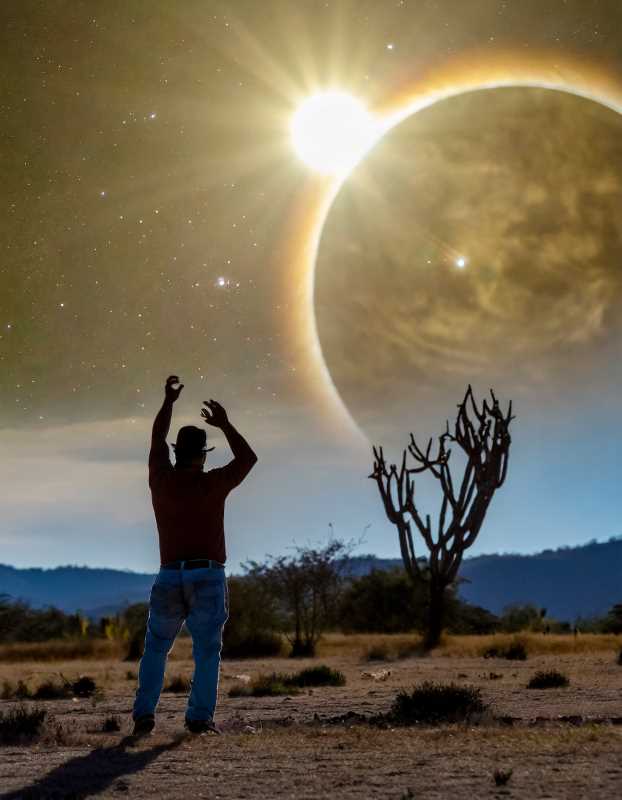Mexico's Yucatán Peninsula Prepares for Eclipsepalooza
Mexico's Yucatán Peninsula gears up for a rare annular solar eclipse, prompting a fusion of science, culture, and measures to combat misinformation. Daniela Tarhuni, a science communicator, leads efforts to provide unique eclipse experiences and train teachers to dispel myths.

In the land where ancient Mayan temples whisper their tales of cosmic connection, Mexico is gearing up for an extraordinary celestial show. On October 14, 2023, the skies over the Yucatán Peninsula will play host to a rare annular solar eclipse, captivating the hearts and minds of skywatchers, curious travelers, and spiritual seekers alike. And this time, it's not just about the eclipse itself; it's about embracing science, culture, and battling misinformation.
Astronomy aficionados and culture enthusiasts have been flocking to Mexico's archaeological sites for years during significant celestial events. Whether to absorb mystical energy, connect with their ancestral heritage, or partake in New Age rituals, these gatherings often strain the very historical treasures they seek to honor.
According to data from the National Institute of Anthropology and History (INAH), during the spring equinoxes in Teotihuacan, crowds have surged by up to a staggering 1000%, putting these precious pre-Columbian heritage sites at risk. Increased visitor numbers translate into higher physical and functional vulnerability for these archaeological zones, potentially endangering the historical relics and the people who visit them.
Enter Daniela Tarhuni, the head of the Department of Science Divulgation at the National School of Higher Studies (ENES) Mérida of UNAM. She recognizes the impending eclipse as a spectacle that will draw crowds like no other, prompting her to lead the charge for a different kind of experience. ENES Mérida, as part of the National Committee of Eclipses Mexico, has devised a plan to create a festival of art, culture, and science across public squares in Yucatán. Their aim? To divert eclipse enthusiasts away from overcrowding the pyramids.
“We want to cover a broad spectrum of the population, without distinctions,” Tarhuni says. Their efforts span across multiple locations, including the port of Sisal and the municipalities of Maxcanú and Tekax. Mérida will host special programs at the UNAM campus and the Gran Museo del Mundo Maya. In a particularly noteworthy endeavor, they will also set up in the Parque Ecológico Metropolitano del Sur Yumtsil, an area marked by high rates of marginalization and vulnerability.
Those who attend these tented venues will have a unique opportunity to set up their projectors, engage in conversations with astronomers, and participate in enlightening workshops. When the moment of the annular solar eclipse arrives, experts will be on hand to guide attendees, explaining every nuance of the celestial event. It promises to be a stark departure from the typical experience at pre-Hispanic sites, where the atmosphere is charged with mystical rituals, palm-raising, percussions, and the wafts of copal smoke.
“We're coordinating with the INAH Yucatán Center,” says Tarhuni. “We invite those who plan to gather at archaeological zones to join us and realize that, when it comes to an eclipse, what's truly important is what's happening in the sky. Whether you're in a public square or a sacred Mayan site, the phenomenon will look the same.”
Eclipses have a magical way of marking themselves in our memories. For Tarhuni, July 11, 1991, at precisely 1:24 in the afternoon, is etched in her heart. This was when one of the longest total eclipses over Mexico City occurred, lasting just over seven minutes. It was the moment that sparked her lifelong fascination with astronomical phenomena and science.

To commemorate the event, she still possesses the Visorsol filter given to her that day, mounted on yellow cardboard with a red Mayan-style eclipse print. She also retains vivid memories of the rumors that swirled, such as the belief that pregnant women should take precautions to prevent cleft palates in their newborns. These stories showcase the power of misinformation and the urgency of addressing it.
To combat the spread of such myths, the National Committee of Eclipses Mexico was founded in 2021. The committee, which includes UNAM through ENES Mérida, Institutes of Astronomy, and Radio Astronomy and Astrophysics, began by training teachers in basic and secondary education. These educators were equipped with the knowledge to share accurate information about eclipses and dispel misconceptions.
As Tarhuni passionately notes, “What better alliance can there be than with teachers? They are our link with children and youth. In short, they are agents of change.”
So, as the Yucatán Peninsula readies itself for the spectacular annular solar eclipse in October, remember to turn your eyes skyward. It's not just about the eclipse; it's about the fusion of science and culture and the battle against the spread of myths. And who knows, as Daniela Tarhuni's own experience shows, an eclipse might just illuminate new vocations and passions for generations to come.




